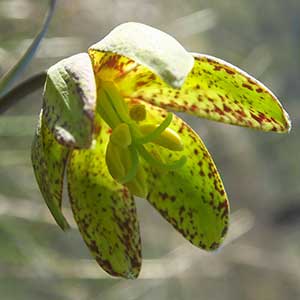Fritillaria glauca
Fritillaria viridea
Siskiyou fritillaria, Siskiyou fritillary, Siskiyou missionbells
San Benito fritillary
large 3–9; small 1–9.
large 3–5; small 0–4.
0.8–2 dm.
3–6.5 dm.
2–4, alternate, 3.5–9 cm;
blade lanceolate-oblong, sickle-shaped, glaucous.
in 1–2 whorls of 3–4 leaves per node proximally, alternate distally, 4–10 cm, usually shorter than inflorescence;
blade narrowly lanceolate;
distal leaves usually ± equaling proximalmost leaf.
nodding;
tepals purplish or greenish marked with yellow, lanceolate-oblong, 1.5–2.5 cm, apex not recurved;
nectaries green with maroon dots, broadly lanceolate, less than 1/2 tepal length;
style obviously branched for 1/2 its length, branches longer than 1.5 mm.
nodding;
tepals pale green to almost black, not mottled, lanceolate, 0.9–1.8 cm, apex not recurved;
nectaries green, lanceolate, ca. 1/2 tepal length;
style obviously branched for 1/2 its length, branches longer than 1.5 mm.
broadly winged.
winged.
= 24.
Fritillaria glauca
Fritillaria viridea
Fritillaria viridea is considered rare and endangered in California. It is closely related to F. affinis and considered synonymous with it by some authors.
(Discussion copyrighted by Flora of North America; reprinted with permission.)


